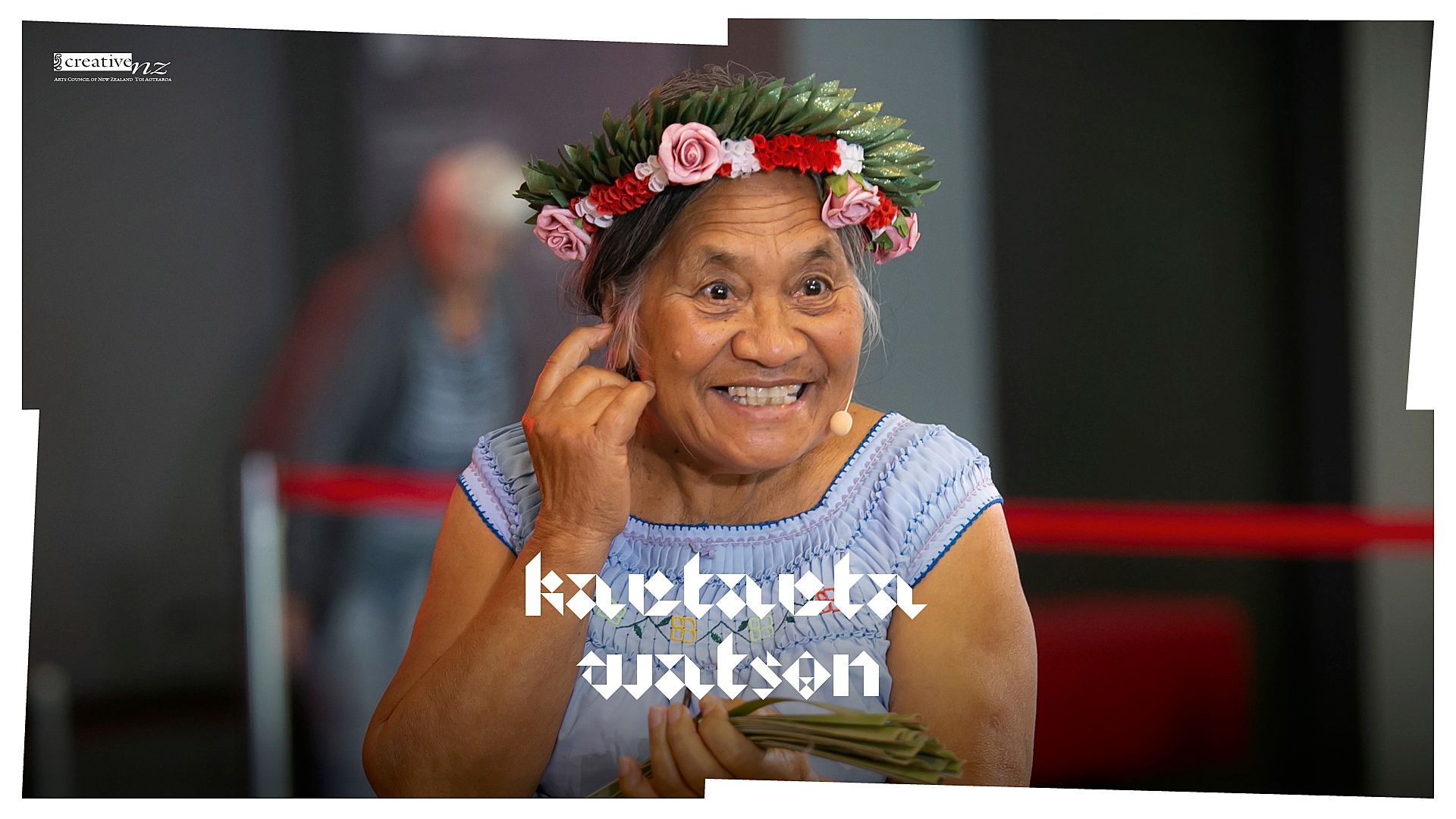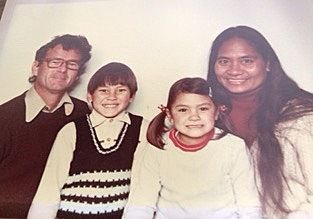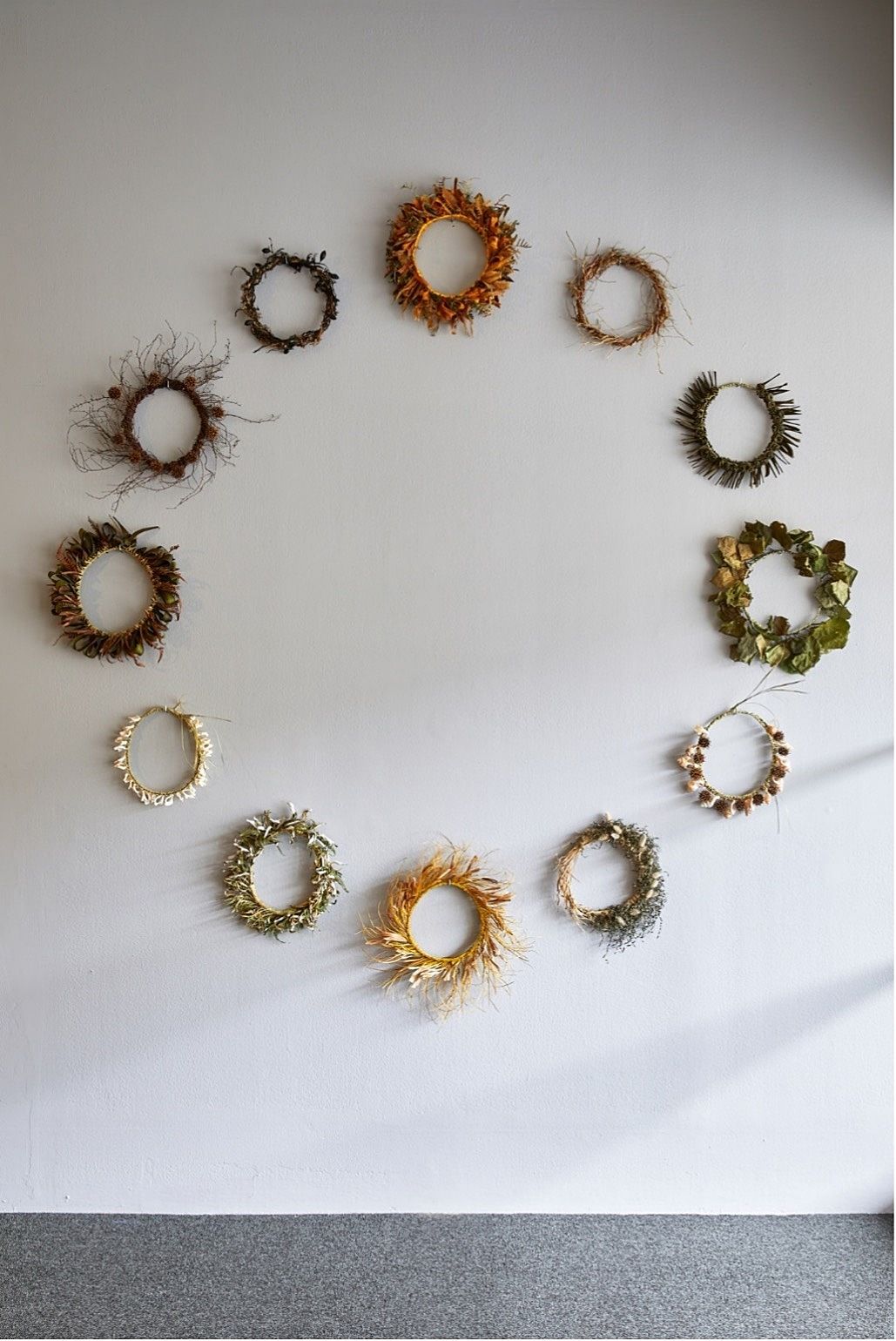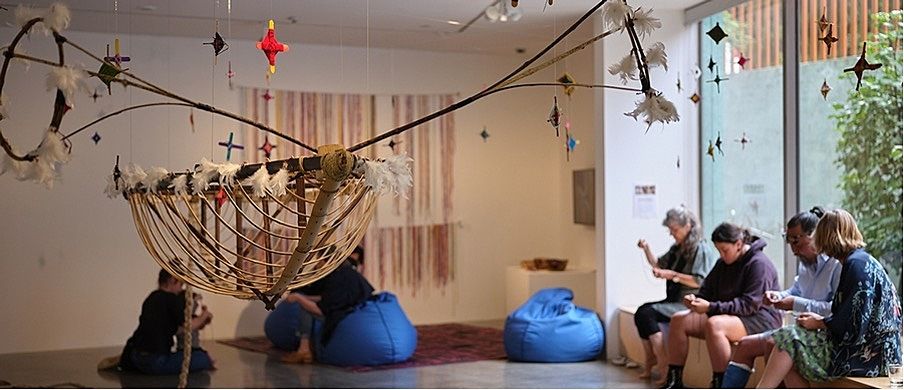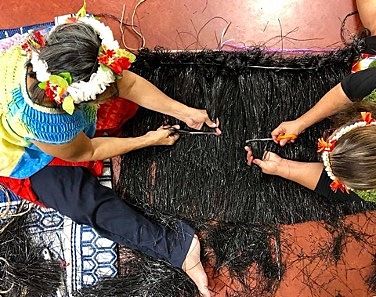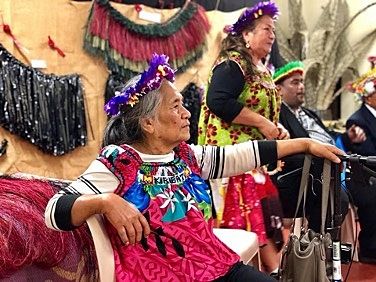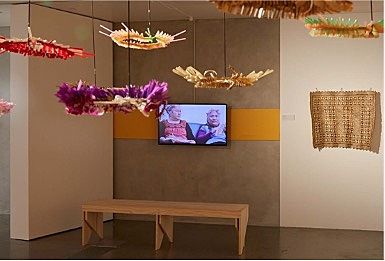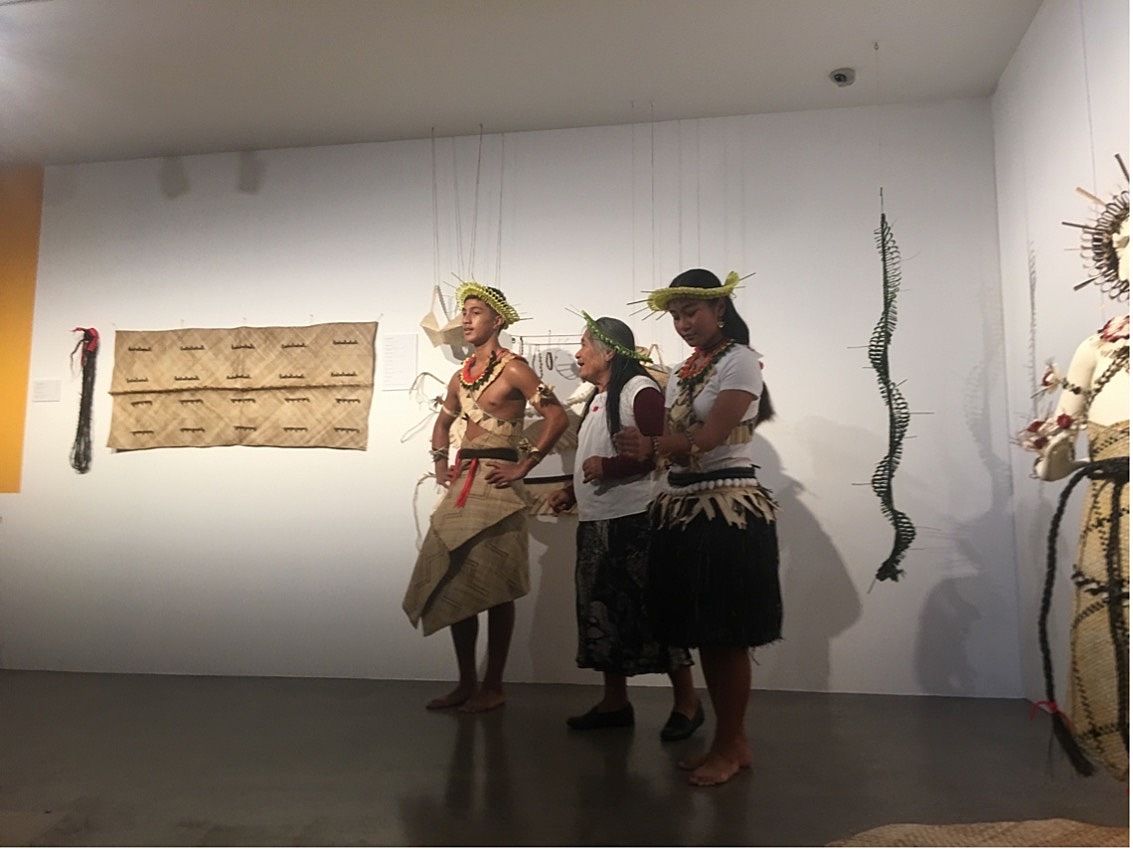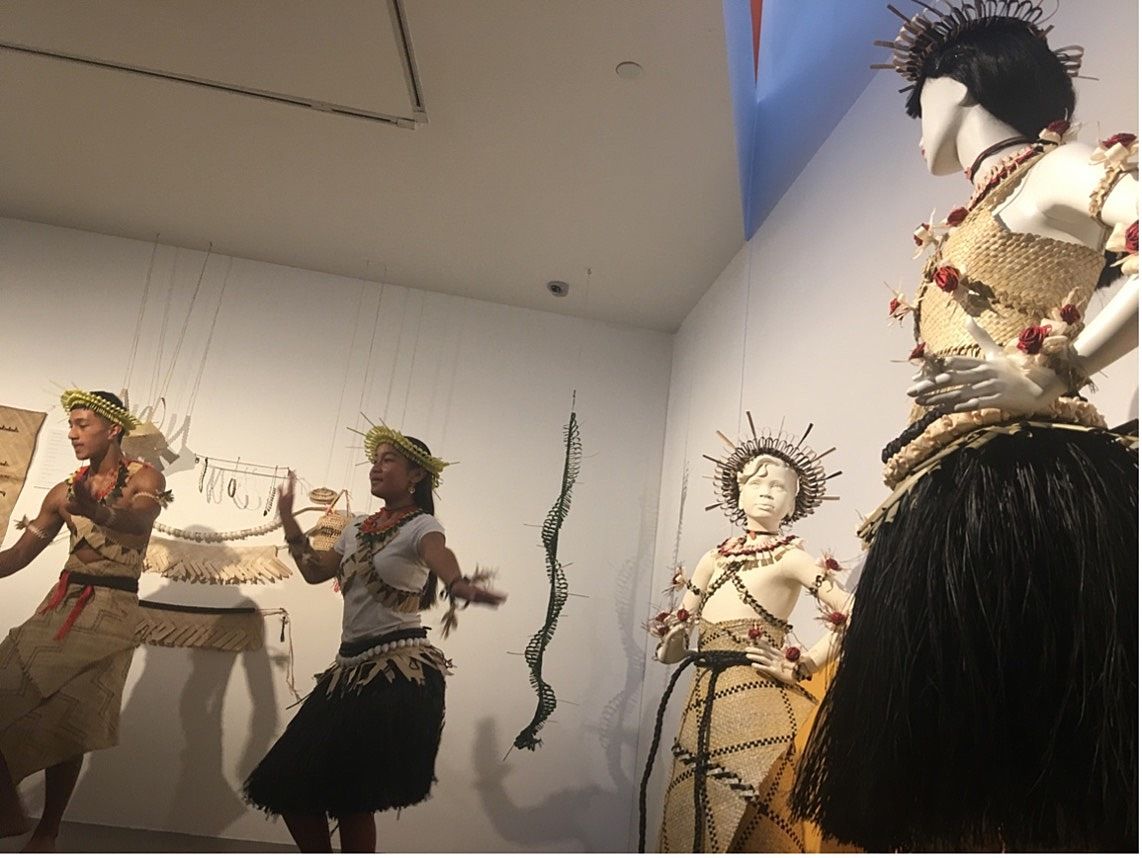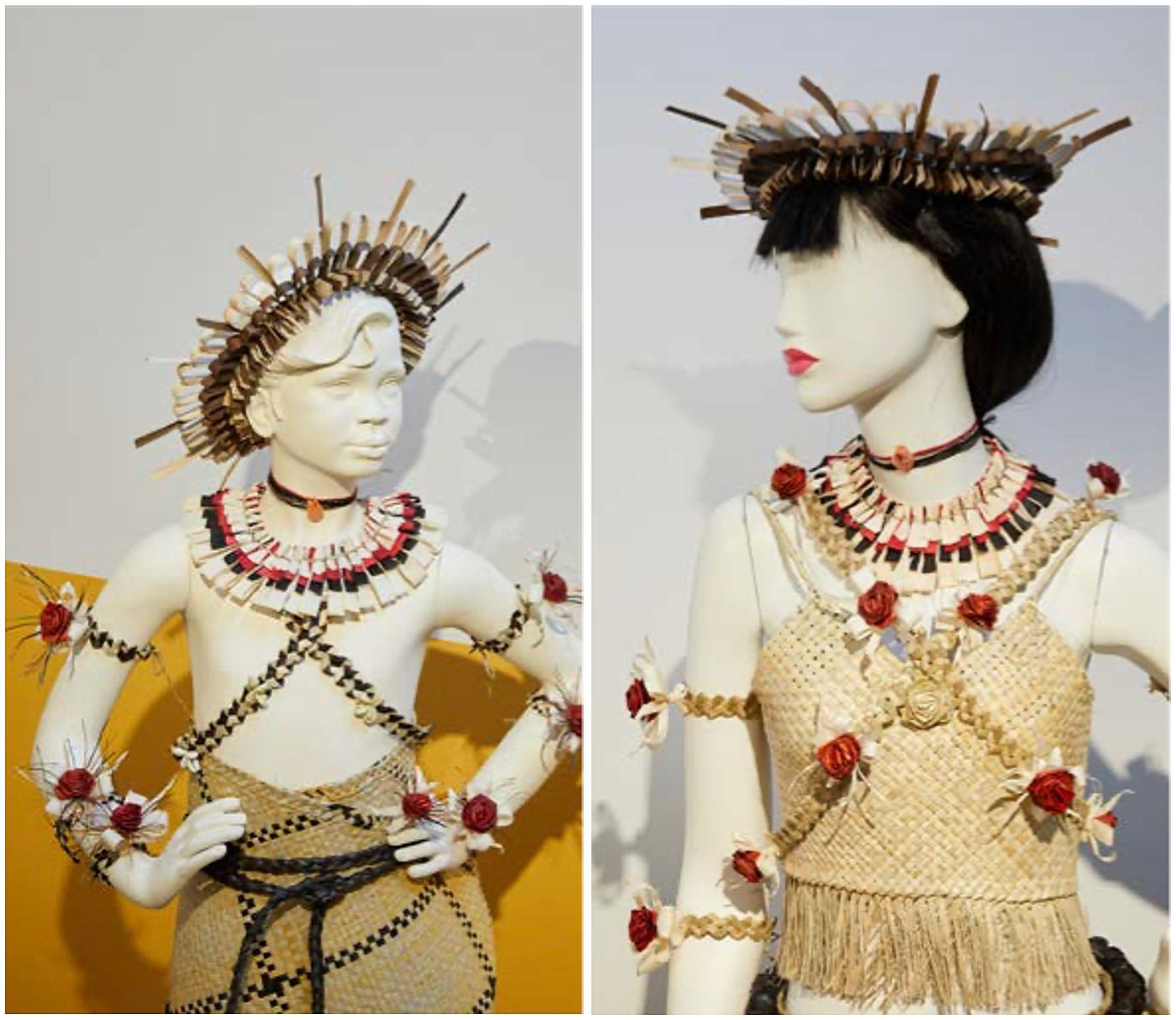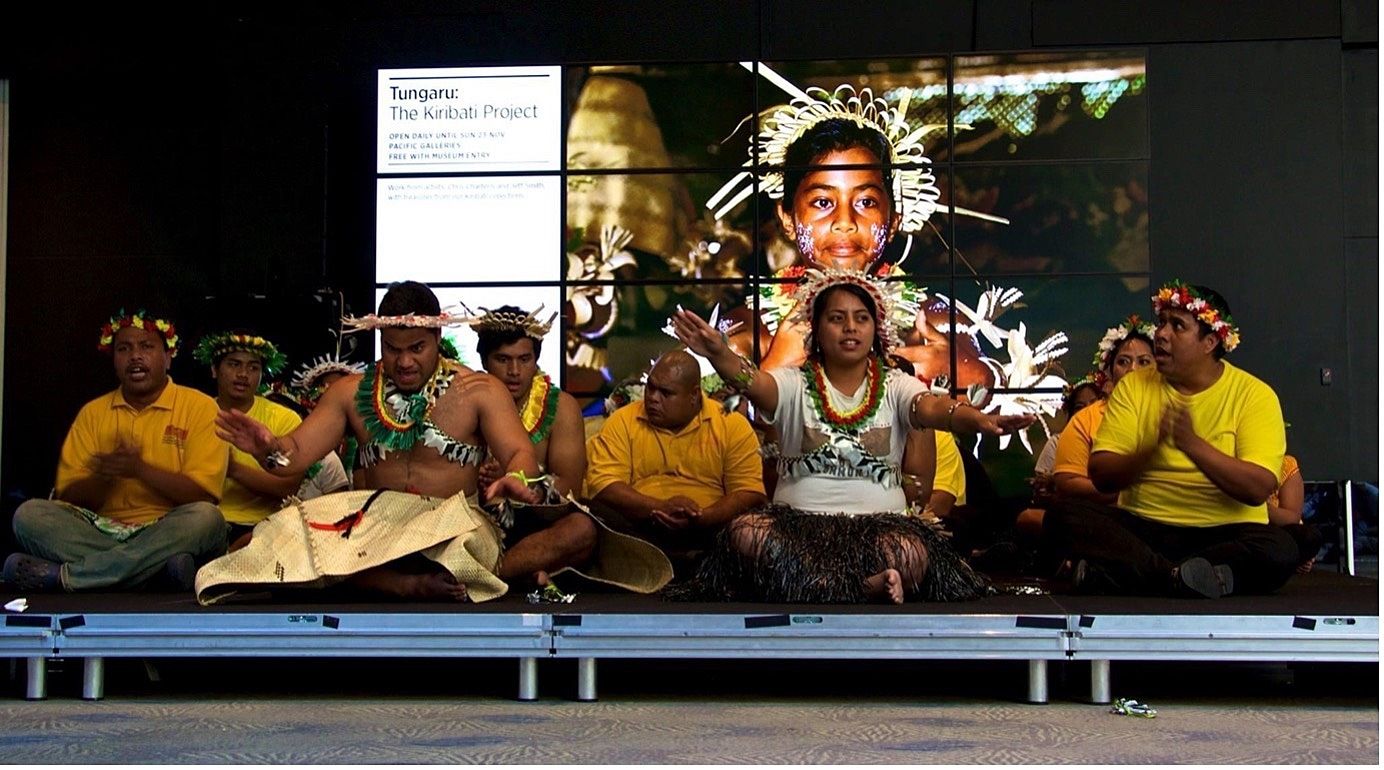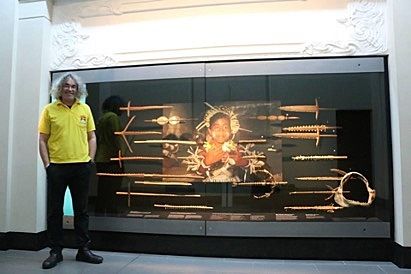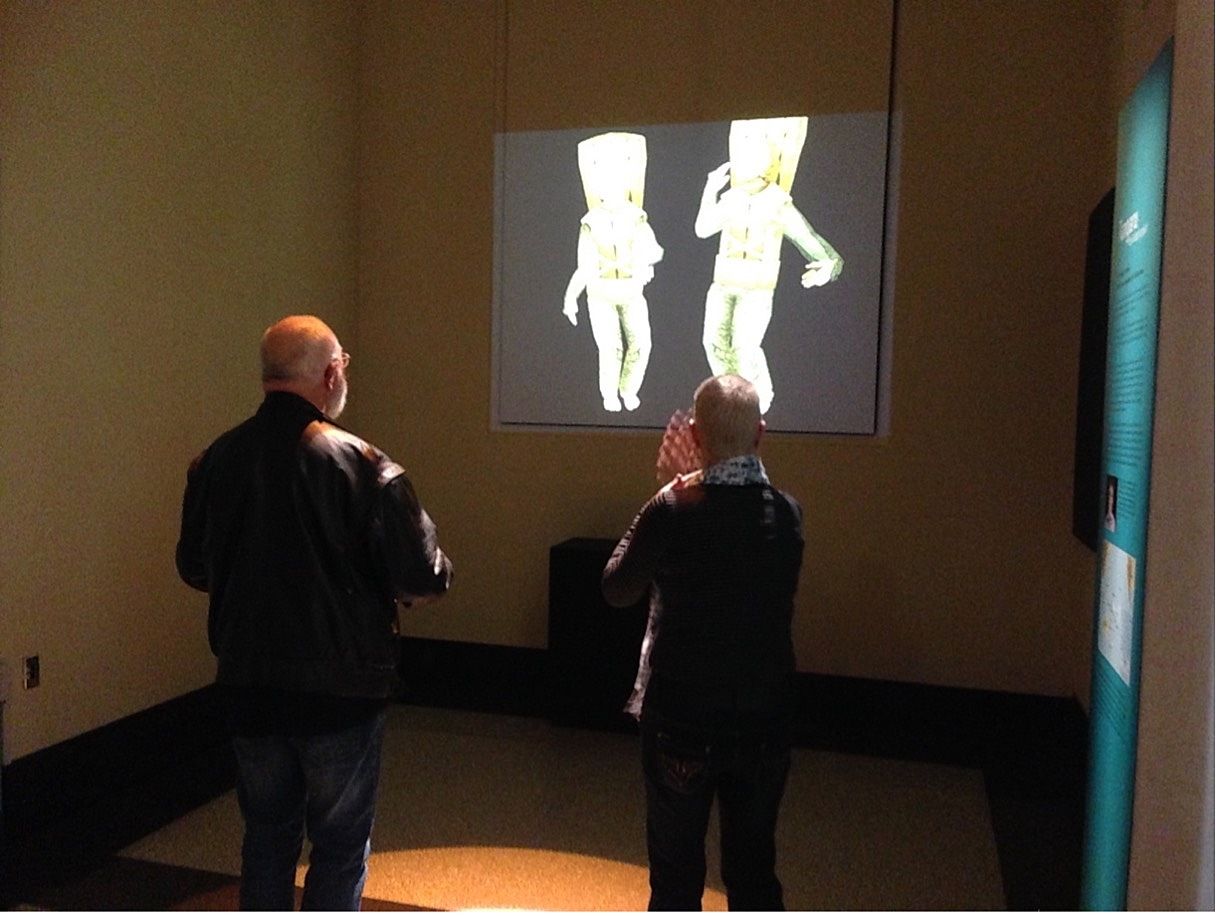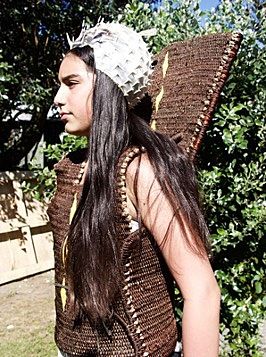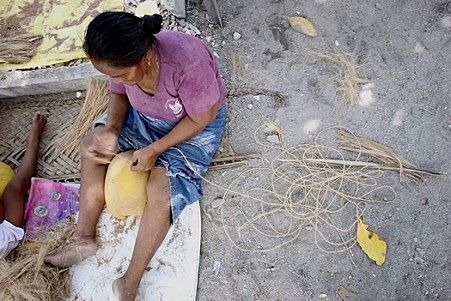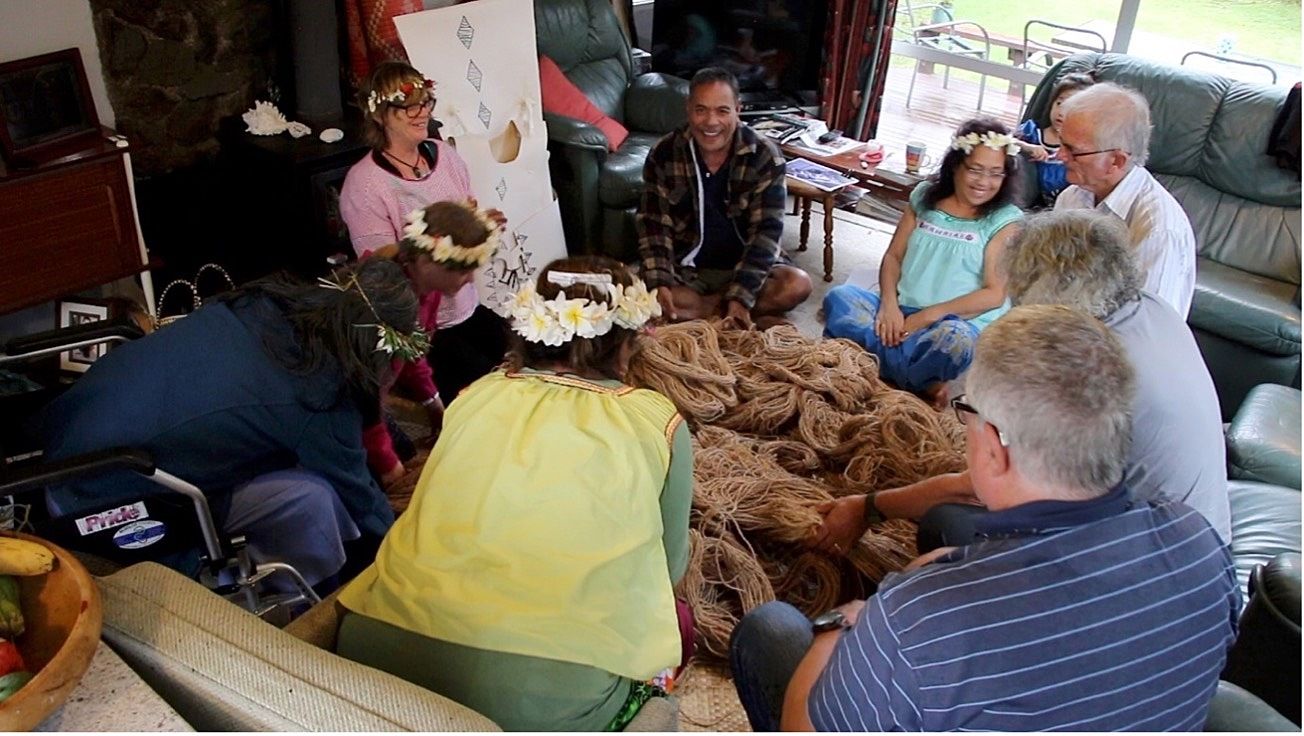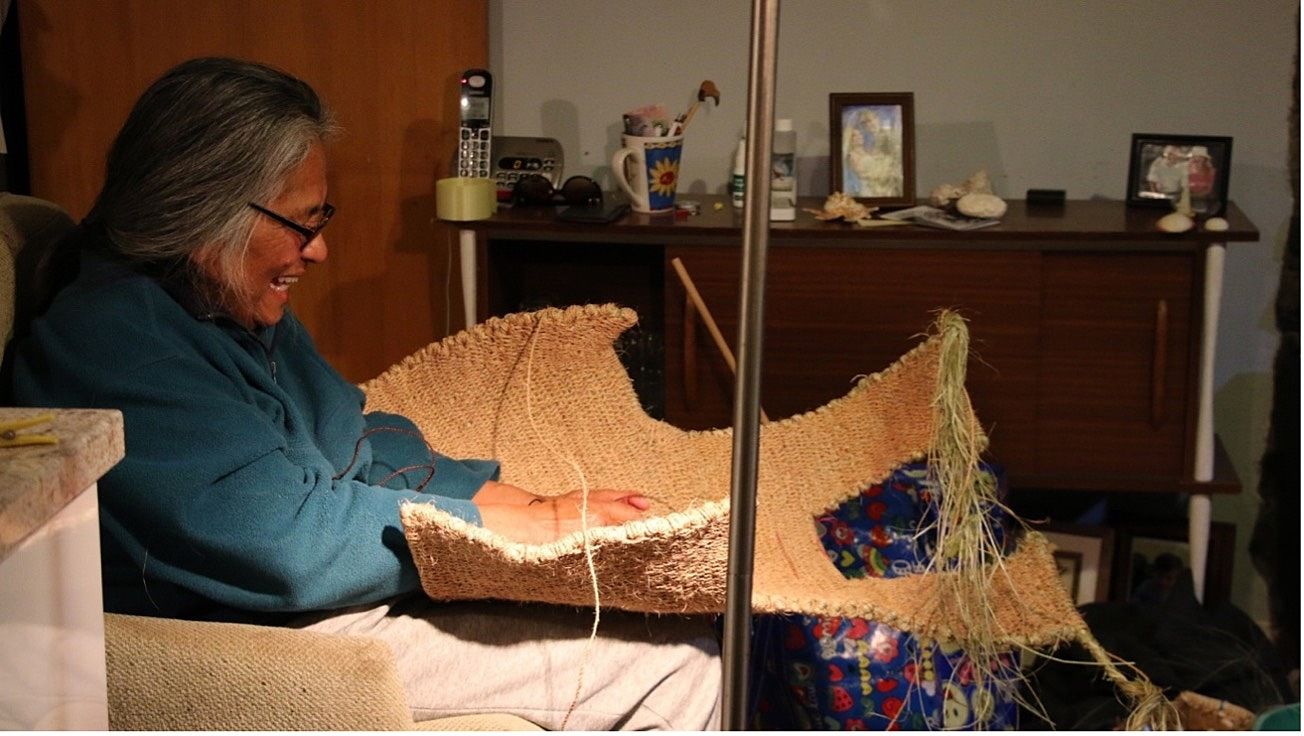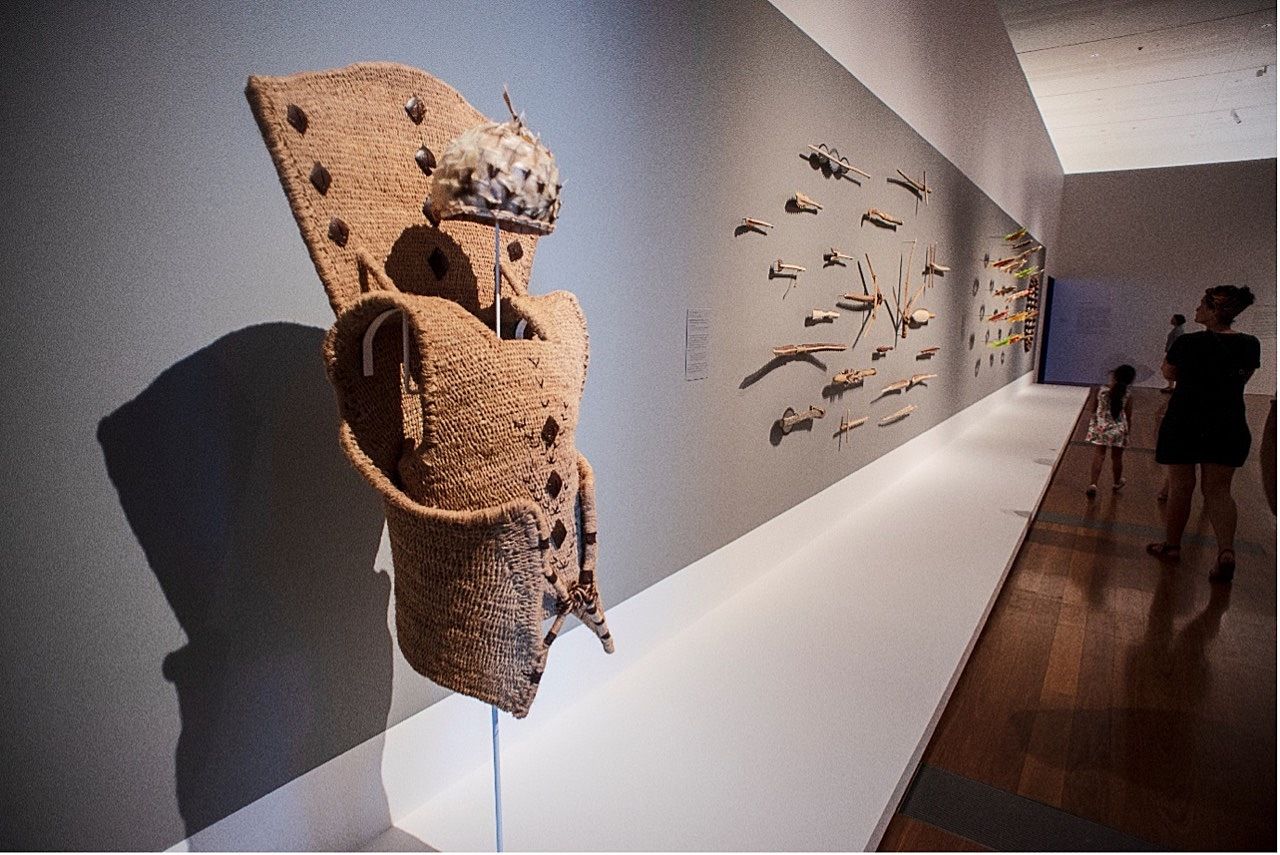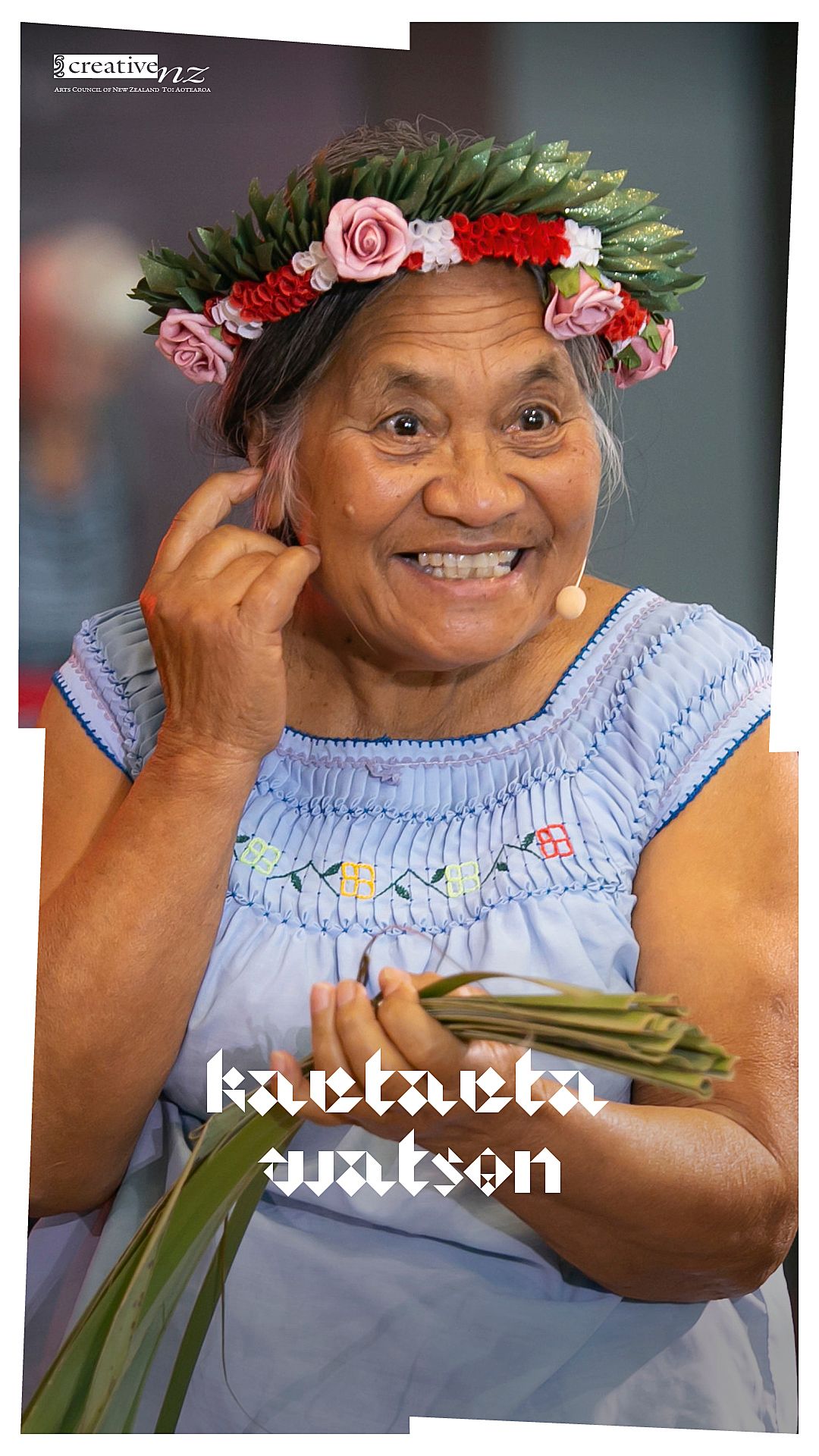People and Blessings
Kaetaeta Watson hopes to inspire others to learn and carry on the I-Kiribati culture she learned from her grandmother and aunties, and growing up in the village.
We’re collaborating with Creative New Zealand to bring you the ground-breaking Pacific Arts Legacy Project. Curated by Lana Lopesi as project Editor-in-Chief, it’s a foundational history of Pacific arts in Aotearoa as told from the perspective of the artists who were there.
Lagi-Maama Academy & Consultancy are honoured to have been brought on by Creative New Zealand to connect with Moana Oceania cultural practitioners as part of this Pacific Arts Legacy Project. It was such a privilege and joy to share time–space with Kaetaeta Watson in her beautiful home in Whiritoa, which, together with her life-long creative partner John Watson, has not only nurtured their family, but supported her many creative ventures and collaborations with fellow artists and their community.
Someone will come up to me and say, “Oh you weave with flax” and I reply, “Yes, I do”, then they say, “Do you think you can make this and that” and my answer is usually, “Oh, I’m sure we can try” (especially if I haven’t made it before). I like to call them ‘challenges and inspirations’, just to weave something different and out of the normal – maybe ‘contemporary’ [laughing]. The more I think about it and the more we talk about it, the more I keep coming back to how I just want to do more. There is so much I don’t understand and don’t know – I have lots and lots of ideas with still plenty to learn from others, and will always give it a go!
L-R: John, Andrew, Susan and Kaetaeta Watson, 1984.
My name is Kaetaeta Watson. I was born in Kiribati on the island of Tabiteuea and I came to Aotearoa with my husband John Watson, who is English, and our little boy Andrew, in 1973. Our daughter Susan was born here in 1975.
When we first came to Aotearoa we lived in the Bay of Islands (Toi-te-Huatahi) for about four years. John was a teacher and taught at Paihia school and I was a full-time mother to our children Andrew and Susan, who are now raising their own families in the UK and Nelson.
When I think of my beginning I think of my grandmother and aunties, and growing up in the village
My Beginning
When I think of my beginning I think of my grandmother and aunties, and growing up in the village. I was the child that someone would say to, “Oh there is a leaf there, can you strip it?” (so they can use it for weaving), and then they would show me how to prepare it and I suppose that’s how I learnt. As I grew older I was shown how to make more complex pieces, so weaving was a vital part of my daily life and culture. It was a matter of ‘doing it and learning to do by doing’ basically from the home, we made things in order to make our lives more comfortable because you had to do things to survive. So, you learn as you go – the trails through the village, under the coconut tree, those were our classrooms of learning.
As children we learnt to make things, like windmills and balls, with the natural resources found in our environment, and what we had we used. We would go to the coconut trees and pick one of the coconuts that were a bit ‘deformed’ to make our dolls, we would use the husk to make their blankets. That is how we made our dolls because we liked dolls, too – it wasn’t just a European thing, it is a universal thing, and we had to be super creative with what we had. I suppose that is where it started, because we had nothing else. If your parents worked in Banaba, for example (as they got paid well), then you might be lucky enough to buy a Chinese doll, but that wasn’t us, so we just stuck with making our own dolls from the materials we had.
We had to be very creative and innovative because of the environment that we were in, but we were blessed as we had so much!
Introduction to Harakeke
My introduction to harakeke was lovely and I must acknowledge the two lovely kuia who shared with me their knowledge of flax. It was a reawakening of my own te rabakau (knowledge) and the beginning of my ‘flax journey’ in Aotearoa.
These kuia taught me so much about working with flax. I had no idea that there were different varieties, I just thought flax was flax, but then as you weave and play around with flax – and you share with others – you find out there are different types.
I was living in the Toi-te-Huatahi when I was first introduced to harakeke. I got to know a couple of kuia who lived opposite the play centre where I took my little boy, and whenever I would plan a trip to go to the next town to do some shopping, one of the kuia would come with me. On one of these trips, together with the kuia, we were passing through a town called Kawakawa, when she said, “Oh can you stop here?”, so I stopped the car. She hopped over the fence with a knife and cut some of the flax. We then came back to her flat and she said, “This is what we use for weaving.” She showed me how to treat the flax and then how to weave a small basket, and this was all fascinating to me because it was the first time I had reconnected with weaving since leaving Kiribati. In Kiribati, everything that we lived in and used we had to make – we lived in a thatched house and slept on the floor on a woven mat – so every opportunity I had to learn here in Aotearoa I took up, and that's where my weaving with harakeke started.
These kuia taught me so much about working with flax. I had no idea that there were different varieties, I just thought flax was flax, but then as you weave and play around with flax – and you share with others – you find out there are different types. You learn and have a better understanding when you handle flax, then you can tell the difference, and which types of flax should be used for what. I have really enjoyed it, especially because it brings back the knowledge that I had when I was little. I started experimenting with harakeke leaves and making wall hangings, little baskets and balls. That's where I started, and I have just kept going.
Connecting with People through Flax
After four years in Toi-te-Huatahi we moved to beautiful Whiritoa, where we have lived and loved ever since.
The community next to Whiritoa is Whangamatā, and they have a garden club that invited me to show them what I do with flax. I love being part of groups like the garden club, the Spinners and Weavers and also a church group in Waihi, because it is always fun together, especially sharing with people that are interested like me. There is also a women's church group that invited me to join their community, which I did and have loved being part of ever since. The big thing for me is I enjoy sharing, and that what I share will continue.
Whangamatā, in the 1980s, had an outdoor language school with mainly foreign students who attended to improve their English, and they asked me if I would be part of the “alternative afternoon activities”. The school would run more formal English classes in the morning and the afternoon sessions included activities like kayaking and weaving. I was asked to be one of the afternoon tutors, which I really enjoyed because of the wonderful people I met. The students and tutor would be dropped off here at my home for our class and then picked up when we finished. Most of the students were quite young, in their 20s, but they all enjoyed playing and learning about flax. They were mostly European, with some Japanese students.
I remember one time when the students came here [pointing to her old activity room turned bedroom] – there were maybe seven or eight in this room, which was an open room then. It was spring and I had lots of beautiful flowers in there, so we made te bau (Kiribati head garland); they were all very happy and went back on their bus so proud of what they made themselves. Some were full of ideas about weaving, some were familiar with weaving, some of them had no idea – so I had to show and demonstrate that you put that thing on top of that and one on the other. I enjoyed all that sort of sharing and also learning from each other. I remember one person, a young Japanese man, while the rest were making small flax balls, he ended up weaving a pair of sandals with flax!
I have had so much joy working and collaborating with different groups and people – because we all have different talents and knowledge
Collaborating “To Keep Learning and Practising”
I have had so much joy working and collaborating with different groups and people – because we all have different talents and knowledge – so we gather to keep learning from each other and practising.
During lockdown in 2020, Maureen Lander approached me about a collaboration on making ‘crowns’. I said we as Kiribati don’t have crowns, but we make te tai, or headdresses, for dancing and we also make baau or head garlands. We then decided that Maureen would make pare, Māori headbands or wreaths, and I would make baau. So during lockdown we collected what we could from the beach and from around our gardens to make our pare and baau. We made a total of 12 pare and baau that were presented in a circle installation titled Baau and Pare (2020) for the exhibition DE-celerate (5 September – 29 November 2020) at Te Tuhi contemporary arts space in Pakuranga, Tāmaki Makaurau Auckland.
Maureen Lander and Kaetaeta Watson, Baau and Pare, 2020, made from miscellaneous natural and man-made materials found in the artists’ environments. Commissioned by Te Tuhi, Tāmaki Makaurau Auckland. Photo: Sam Hartnett
I had worked with Maureen Lander and other members of Ngā Turuturu o te Tara (Coromandel Weavers Collective) on the Star Waka project in 2019, as part of the events in Whitianga for the Tuia 250 commemorations. This project was led by Chris Charteris and Maureen. As part of this project, we made a long rope made of flax, and Chris created the shape of the canoe and made it with bamboo. Star Waka was then displayed at Te Uru Waitākere Contemporary Gallery (12 December 2020 – 28 February 2021), followed by a showing at Whakatāne Museum and Arts (2 October 2021 – 9 January 2022).
Star Waka at Te Uru Waitākere Contemporary Gallery (12 December 2020 – 28 February 2021). Photo: Sam Hartnett, courtesy of Te Uru Waitākere Contemporary Gallery
Connecting and Collaborating as I-Kiribati
I also thoroughly enjoy working with Louisa Humphry – it’s always been the two of us and our beloved husbands. We would get together a lot (and invite others) and bring flax, then someone would bring a picture of, say, a rose they saw in a magazine and then we would spend the whole night trying to work out how to weave the body and then make the rest using flax. We had (and still do have) such fun times making together.
We love to experiment with new materials. We have been involved with the Pacifica Mamas over many years, and of course working together and running workshops with our own Kiribati community in Tāmaki Makaurau. For one of our workshops, Te Karao Bwai ni Mwaie (organised by Pasifika Migrant Services, funded by Creative New Zealand and hosted by the Pacifica Arts Centre), we used weed mat to make our female dance skirts.
Te Karao Bwai ni Mwaie workshop showing the process of making a female dance skirt from plastic weed mat. Photo courtesy of Pacifica Arts Centre, May 2018
Te Karao Bwai ni Mwaie workshop with some of the completed female dance skirts made of natural and dyed flax, raffia and plastic weed mat. Photo courtesy of Pacifica Arts Centre, May 2018
In 2019 Louisa Humphry and I were part of the exhibition names held in our mouths (8 June – 18 August 2019) at Te Uru Waitākere Contemporary Gallery, curated by Ioana Gordon-Smith, with Sosefina Andy, Nikau Hindin, Wikuki Kingi Jr, Pacifica Mamas and The Veiqia Project. We made te tai/te etete, headdresses, from harakeke (natural and dyed flax) and plastic straws. We also made bwai ni mwaie female and male Kiribati dance costumes, where we mixed our use of flax (natural and dyed) with dried corn husks (natural and dyed). The male te kabae (dancing mat) was woven from processed flax and the female te riri (dancing skirt) was made from black-dyed flax. The te karuru (arm decorations), te ramwane (sash) and mwaen te roroa (chest garland) were woven from natural and dyed corn husks. Securing the male dancing mat was a te nuota (belt) made from fine, braided black-dyed muka to look like hair.
Installation of te tai/te etete, headdresses, made from harakeke (natural and dyed flax) and plastic straws, by Louisa Humphry and Kaetaeta Watson for the exhibition names held in our mouths (8 June – 18 August 2019), curated by Ioana Gordon-Smith. Photo: Sam Hartnett, courtesy of Te Uru Waitākere Contemporary Gallery
Kaetaeta Watson and two I-Kiribati dancers, Aviu and Davina Aviu, at the opening of names held in our mouths. Photo courtesy of Lagi-Maama Academy & Consultancy
Kiribati performance by Aviu and Davina Aviu at the opening of names held in our mouths. Photo courtesy of Lagi-Maama Academy & Consultancy
L-R: Male and female bwai ni mwaie (dance costumes) made by Kaetaeta Watson and Louisa Humphry for names held in our mouths. Photo: Sam Hartnett, courtesy of Te Uru Waitākere Contemporary Gallery
Collaborating for Our Beloved Kiribati
It was around 2001 when I met Chris Charteris and his wife Lizzy Leckie. Someone from the Coromandel had approached us during Pasifika and said you need to meet Chris and his wife, so they took our contact details and we connected. This led to my collaborative creative journey with Chris and Lizzy, when they asked me to be involved with Tungaru: The Kiribati Project. I was involved with the translation and providing Kiribati cultural advice. There was a publication and two exhibitions – at Māngere Arts Centre Ngā Tohu o Uenuku (12 July – 24 August 2014) and at Tāmaki Paenga Hira Auckland War Memorial Museum (5 July – 23 November 2014). For the Tāmaki Paenga Hira component, I was approached to provide Kiribati knowledge and practice around their exhibition content: Bwebwerake – To Grow to Evolve, a display featuring ten swords by Chris Charteris and an image by the late photographer and educator Professor Tony Whincup; and Te Tia Buaka ni Kiribati – Kiribati Warrior, a 3D interactive piece by Jeff Smith. I also provided the Kiribati translation for the exhibition labels.
Kiribati Waikato Association performing at Tāmaki Paenga Hira Auckland War Memorial Museum as part of Rungan Kiribati: Kiribati Day (Saturday 11 October 2014). Photo courtesy of Tungaru: The Kiribati Project
Chris Charteris in front of Bwebwerake – To Grow to Evolve at Tāmaki Paenga Hira Auckland War Memorial Museum. Photo courtesy of Tungaru: The Kiribati Project, July 2014
The late photographer and educator Professor Tony Whincup with his wife Joan Whincup, viewing Te Tia Buaka ni Kiribati – Kiribati Warrior by Jeff Smith at Tāmaki Paenga Hira Auckland War Memorial Museum. Photo: Kolokesa U. Māhina-Tuai, August 2014
We connected again for the 12th Festival of Pacific Arts in Guam in 2016 – Chris, Lizzy and I represented Kiribati with the Aotearoa New Zealand contingent. And it was there that we met Dr Alison Clark, who had stopped in Guam after her trip to Kiribati, where she was researching and seeking out a maker of our te otanga (Kiribati armour). We met with her and she explained that, based on her research, the last known armour was made in 1957, when Prince Philip went to Kiribati and was gifted it. The information also said that the maker came from Beru, one of the outer islands, but when Alison had gone out to see if there were any makers on that island she was unable to find one. So when she asked if te otanga could be made, Chris looked at me and I said, “We can try” [laughing].
Te otanga (Kiribati armour), modelled by Isabella Moarerei Levet, Kirikiriroa, Aotearoa, and made by Kaetaeta Watson, Chris Charteris and Lizzy Leckie for Pacific Presences, Museum of Archaeology and Anthropology, Cambridge, UK. Photo: Lizzy Leckie, February 2016
We set out to make te otanga for, and supported by, the Museum of Archaeology and Anthropology (MAA), University of Cambridge, UK. We started with research trips here in Aotearoa New Zealand, which included visiting Te Papa Museum and Tāmaki Paenga Hira. And when we travelled to the UK and Europe with our completed te otanga, we even went to museums in Berlin and Germany, including Cologne, which was amazing. We attended the opening, held in Cambridge, which was lovely. Te otanga was made for the Pacific Presence exhibition – it was made from synthetic string and is now in the collections of MAA, University of Cambridge. However, we took some coconut fibre with us to the UK museums and demonstrated the making of the armour with te kora (coconut-fibre string) which involved a huge amount of preparation and process. When we were at MAA, we held a workshop where we demonstrated the ‘rolling’ of the coconut fibre to make the string that is needed to then make the armour. I remember some of the Pitt Rivers Museum (and other) staff trying to roll the coconut fibre, which stuck in my head because even the process of rolling just the coconut fibre is not easy.
Kaetaeta Watson demonstrating the rolling of the coconut fibre to make te kora (coconut-fibre string during a Kiribati weaving workshop held at the Museum of Archaeology and Anthropology (MAA), Cambridge, UK. Photo courtesy of MAA, 5 April 2017
Chris, Lizzy and I were involved in making another te otanga for the 9th Asia Pacific Triennial of Contemporary Art (APT9) (Queensland Gallery of Modern Art, Brisbane, 24 November 2018 – 28 April 2019), a project that included Louisa Humphry, and Mwemwetaake and Rareti Ataniberu. This time we were making a suit of armour ‘traditionally’, and Louisa and Lizzy went back to Kiribati – thanks to Creative New Zealand – to buy te kora, the coconut-fibre string This was sourced from the villages of Koinawa, Tebunginako and Nuotaea on the island of Abaiang. Making the coconut fibre string is a lengthy and tedious task, and we needed huge amounts, so we are thankful for the knowledge and skills of our string makers Rakera Teitibora, and Tiobia and Tiebane Boiaki.
The process of making te kora, the coconut-fibre string Ambo Island, Tarawa, Kiribati. Photo courtesy of Lizzy Leckie
Photograph taken at Kaetaeta and John Watson’s home in Whiritoa, where they went through a process of blessing the coconut-fibre string before they embarked on their making journey.
Before we started using the string to make te otanga, we went through a process of blessing it first. Our home in Whiritoa then became one of the gathering spaces for our group, and during that time it was buzzing with conversations, laughter and making during the day and even through the evenings! We also had additional help in the making of the armour from Tetairua Ataniberu and Bateriki Nabeia. [Kaetaeta reflected on her team’s learning through looking, and remembering when they viewed te otanga collections in museums and saw that the knots looked similar to her dad’s fishing knots.] We then went to Brisbane for the opening of APT9, and one of the interesting things was seeing all the diverse artists and what they all produced and created – it was amazing!
Kaetaeta Watson making part of the armour in her home at Whiritoa. Photo courtesy of Lizzy Leckie
L-R: Chris Charteris, Kaetaeta Watson, Louisa Humphry, Rareti and Mwemwetaake Ataniberu, Mark Adams and Lizzy Leckie. Photo courtesy of Lizzy Leckie
Tungaru: The Kiribati Project at Queensland Gallery of Modern Art (QAGOMA) as part of the 9th Asia Pacific Triennial of Contemporary Art (APT9), 24 November 2018 – 28 April 2019. Photo: Raymond Sagapolutele
I would say the most rewarding thing for me is the collective collaborations, and particularly working on the armour – I suppose because it connected me back to Kiribati
I would say the most rewarding thing for me is the collective collaborations, and particularly working on the armour – I suppose because it connected me back to Kiribati, and especially when we had someone going to do research back in Kiribati and couldn’t find anyone – how sad is that? We even had an enquiry from Kiribati, wanting the armour we made for APT9 to be displayed at the Kiribati pavilion in Dubai – surely there will be people back home making or knowing how to make te otanga? I suppose this encourages me to go back to those things and find out more, but then sometimes I think, who is interested? Are the young ones interested? My desire is always to teach and to show our young ones how to make a ball or a little basket – how great that would be.
Flax Journey Continues, but through a Kiribati Lens
I love a challenge – I love to try! For me it’s my upbringing, what I’ve learnt and where I have come from, always from my Kiribati culture, te rabakau (knowledge), that I have, then I use the materials I have available, whether they be flax, plastics or straw. Sometimes the inspiration comes from other people, too.
With the local groups I belong to, every year we have a ‘challenge’ where each member makes an art piece based on a theme – I’ve been doing them for the last four years and really enjoy it. The year we were making te otanga for the Museum of Archaeology and Anthropology in Cambridge, I titled my piece Binding together, as that project had a huge impact on me, and someone really liked the piece and bought it. Last year’s theme was ‘From where I sea’; I tried to weave the scene from when I stand on the beach here in Whiritoa and look to the ocean. Then we had an exhibition with two of the other artists for a festival called Big Day Out and someone liked my piece there and bought it, so I have been very contemporary throughout my work, which excites me every day.
Earlier this year a friend of mine wanted a gift – a wall hanging – but she wanted it green and ‘natural’, so I made it and she picked it up yesterday. She really liked it and said she was going to frame it, and I said I would love to see it once it’s framed – she lives here on the beach. We have another friend of ours that lives here on the beach and he is a wood turner, he is making a mussel shell from wood and he is another one I work with locally – you see we have a wonderful community bartering system around here.
A couple of months ago we had our ‘art mingle’ in Whangamatā, where I am a member of the Arts Collective. Each member was invited to bring one or two pieces to display, mine is a wall hanging – its blue and natural, all woven altogether. I had to name it (see that’s the other thing, naming it) so I discussed with John, who does lovely calligraphy, and together we named it Sand and Sea Mingle because that’s where we are.
Bernadette Ross and Kaetaeta Watson enjoying a catch-up at the Arts Collective Whangamatā event. Photo: Alison Smith, courtesy of the Bay of Plenty Times
Sometimes people would say I want a kete (bag) like ‘that’ and I would say I can make one with harakeke but in a Kiribati way. I had someone pop in the other morning and say, “Oh, you are still here”, and I said, “Yes, I am still here.” She asked me to do something which I had never done before, a baby’s bassinet make from harakeke, then she gave me a picture, so I made it and she took it away and put a lining on it.
I was asked to co-teach a course with someone recently, and when she introduced herself she had a number of different qualifications; and when I introduced myself, I said, “Well, I don’t have any of those papers because I was taught by my aunties, by my grandmother, my mother, and was reared in village knowledge.”
Passing on knowledge
I was asked to co-teach a course with someone recently, and when she introduced herself she had a number of different qualifications; and when I introduced myself, I said, “Well, I don’t have any of those papers because I was taught by my aunties, by my grandmother, my mother, and was reared in village knowledge.” We from the ‘islands’ all have ‘home knowledge’, because it comes out of necessity, because you can’t just go and buy [things] – we didn’t have the money, anyway.
We have to appreciate where we come from before we can change anything else. It’s truly a balancing act, and finding out where you are going and what you want to make. When our children went to school, they were taught in the academic way but nothing in a Kiribati cultural way, but they need to get their education too. That is why we are so keen to share what we know.
Sometimes people will say, “Oh you make it look so easy”, but know it isn’t. Hopefully that plants the seed and if they can see what we are doing (and be inspired) then hopefully they will want to come, learn and carry it on. You do what you can now!
L-R: Louisa Humphry, Toluma‘anave Barbara Makuati-Afitu and Kaetaeta Watson at the end of their weaving workshop as part of names held in our mouths. Photo courtesy of Lagi-Maama Academy & Consultancy
Louisa and I are willing and wanting to share our knowledge and to show anyone who is keen to learn the ways we know and how they were taught to us. But how do we ignite interest – how do we connect and share our Kiribati culture and its richness?
People often say to me, “Why don’t you do a website?”, but I say I do it my own way, if people really want me they will find me, and sure enough they do. I had one lady [who went] to the local shops, saw some of my weaving being displayed, and got my number and address from the lady at the shop. For me, I enjoy it that way. If someone really wants to, they will find me, plus I’m always at the market as well.
Kaitibo: Kiribati Language and Cultural Enrichment camp, at Papamoa Christian Holiday Camp, 14 – 16 January 2022. Photo courtesy of Vicki Ryan
Blessings
Our church community is quite small, so we decided a few weeks back that everyone was to bring either a reading or an item that has meaning to them on their journey. One brought a book and read part of a passage that was inspirational to them. So they went round, and when it got to me I said I didn’t bring anything. I shared that I could have brought my weaving or my bible that my uncle gifted me, but for me it goes deeper than that, it’s seeing people. People around me are the ones that help me along.
I have been very blessed, because I’m able to do these things and pass on the skills and knowledge I have to others. I would have never have dreamed I would be able to do some of the things I have done, but I did them. So I think that is the big thing for me – I’ve been blessed with all the things I’ve been able to do, and always together with John and others that have blessed my path.
*
This piece is published in collaboration with Creative New Zealand as part of the Pacific Arts Legacy Project, an initiative under Creative New Zealand’s Pacific Arts Strategy.
Lana Lopesi is Editor-in-Chief of the project.
Series design by Shaun Naufahu, Alt group.
Header photo by Jo Moore courtesy of Museum of New Zealand Te Papa Tongarewa
